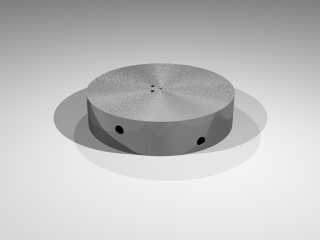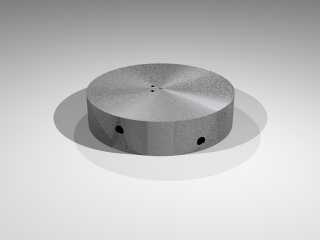|
 |
Thanks Rune. I thought of using wood or onion, but the good thing about spiral
is that in addition to giving the nice radial pattern on the face of the metal
cylinder, it _also_ gives fine grooves along the length of the metal cylinder.
Have a look at machined metal cylinders and you'll notice them. They are
responsible for some nice highlights along the length of a metal cylinder, and
using spiral, POV can simulate these to a much greater extent than wood (I don't
know about onion, but I might place a bet on "probably not"). I've attached two
pics of the different effects. The tex is the same as I posted before for
spiral, and wood is very similar (replace spiral1 with wood, and up the
frequency a bit (~*1.25) to get a similar pattern). Note the different effects
on the length of the cylinder, and the way AA depth of 3 (chosen for speed) adds
alot of artefacts.
Could you please give a quick example of the averaging of normals method? I
don't quite follow.
MJL
Rune wrote:
> "Mark James Lewin" wrote:
> > Attached is a jpg of part of a simple scene I am doing that
> > involves metal textures. At present, the render is taking
> > _far_ too long, because to avoid aliasing errors, I've had
> > to use sampling method 2 at a depth of 5.
>
> I've made a CD Include File where I needed the color effects to work in a
> little similar way. I know a method that worked very well for me.
>
> First let me say that using a union normal instead of spiral wouldn't make
> any difference, because your frequency is so high.
>
> Also, first let me say that you should NOT use a radial pattern. It is a
> great misunderstanding to think that radial normals produce radial-like
> reflections. Union or wood is the way to go.
>
> And now to the point. In your texture you need rings that are so small that
> the individual rings are "invisible", and you use high frequency and slow AA
> to do that. However, you can fake infinitely thin rings by using a onion (or
> wood) pattern that is scaled so big that it doesn't repeat at all. You need
> to use an average of two such normals - they must be the same, except that
> the one must have a positive normal, while the other must be negative. Also
> remember to use ramp_wave.
>
> If you need more help with it, please tell me, and I'd be more than happy to
> help!
>
> Greetings,
>
> Rune
> --
> \ Include files, tutorials, 3D images, raytracing jokes,
> / The POV Desktop Theme, and The POV-Ray Logo Contest can
> \ all be found at http://rsj.mobilixnet.dk (updated July 23)
> / Also visit http://www.povrayusers.org
Post a reply to this message
Attachments:
Download 'wood.jpg' (13 KB)
Download 'spiral1.jpg' (14 KB)
Preview of image 'wood.jpg'

Preview of image 'spiral1.jpg'

|
 |




![]()